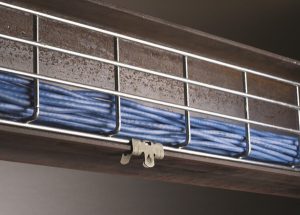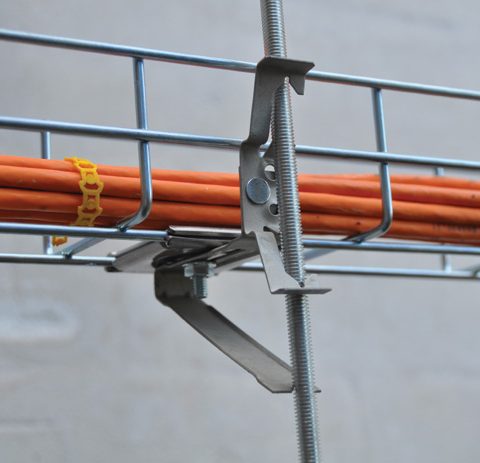In an increasingly connected world, the number of cables to be installed and securely supported in commercial structures is ever growing. Our goal at nVent CADDY is to help end users accomplish this in the most efficient way possible, every step of the way—whether they’re supporting large bundles of cables transferring data or running single cables that provide power where it’s needed.
We offer a broad range of cable management solutions that empower electrical contractors, design engineers and project foremen to efficiently position and support cables, protect the integrity of cable function and keep installation costs low during construction. Which cable management setup makes the most sense for a given application depends on several factors, and in this blog post, we explain what you should consider when seeking the right solution for a specific situation.

What kind of cables are you running?
The first thing to consider is what type of cables need to be supported.
For example, the needs of power cables versus datacom versus Power over Ethernet (PoE) cables are different. In PoE applications—such as we see in wiring for LED lights, security, building automation, Voice over Internet Protocol (VoIP) phones, internet-connected cameras and wireless access points—large bundles of cables can emit enough heat to jeopardize datacom functionality. As a result, you may need to design your cable support system in a way that allows for appropriate heat dissipation. Avoiding running cables in conduit, limiting cable fill rates in cable trays and spreading out cables can help encourage air flow, keeping cables cooler.
In datacom wiring applications, you may also need to keep bending radii in mind, as transmission integrity could suffer if cables are bent at extreme angles.
EN 50174-2 for cabling installation planning and practices inside buildings requires a minimum bend radius of eight times the cable diameter for four-pair balanced cables during and after installation, for example.
Finally, the type of cable you are running and the system it powers can also affect whether you need fire integrity-rated products according to DIN 1402-12. For more information about the standard and about structural integrity requirements for fire-rated systems, see our recent blog post.
Once you’ve established your heat dissipation, bend radius and fire-resistance needs, it’s time to think about cable support system construction.
Do you want a continuous or noncontinuous system?
Continuous support systems consist of cable trays or other supports that run along the entire length of a cable run. In PoE applications, these may be perforated to allow heat dissipation or designed in a way that wires are spread out to avoid heat buildup. Alternatively, noncontinuous options provide support at intervals for cables. J-hooks, especially popular in North American datacom applications, are an example of a noncontinuous support component that holds up cables at a lower cost than cable trays while providing strong heat-dissipation performance.
Noncontinuous pathway support solutions like J-hooks are up to 70% faster to install than continuous solutions, are often more cost-effective and tend to require less material. However, many contractors and designers in Europe, especially, are more accustomed to continuous solutions like cable trays and thus favor them in most applications. Regardless of your preference, nVent CADDY offers a wide variety of both continuous and noncontinuous fixing, fastening and support products, providing many options for effective cable management design.
How big is your bundle, and where is it?
Keep in mind that as cable bundles branch out and lead to locations across a building, you may want a mix of solutions designed to hold different quantities, sizes or types of cables.

- To support large cable bundles, a continuous solution featuring a cable tray system supported by nVent CADDY Universal Tray Supports will allow easy access to cables after an installation that is much less labor-intensive than a traditional method. Other innovative support systems like nVent CADDY Wire Basket Support Clips and nVent CADDY Rod Lock Telescoping Strut Replacements will make the installation a lot faster and less cumbersome.
- For medium cable bundles, you may not need to use cable trays. You can use the nVent CADDY Cat HP J-Hook System as a cost-effective means of keeping your cables elevated and appropriately bundled.
- For small bundles or single cables, an nVent CADDY Metal Pressure Clip that clamps cables directly to a surface can be easily used.
- On rooftops, and in some cases under raised floors, a tool-free, surface-mounted support structure like the nVent CADDY Pyramid Rooftop System keeps cable trays elevated and protected.
- In any application, you will also want appropriate nVent CADDY Concrete Anchors to ensure your cable pathways will stay properly attached when exposed to vibration, fire or other forces.
For an idea of what these various products look like in an application and when it is appropriate to use them, watch our cable management video. Also, for more in-depth product information, browse through our Datacom Solutions brochure. While there is no “one size fits all” solution to cable pathway management, the good news is that you can find just about everything you need for your application through a single provider like nVent CADDY.


